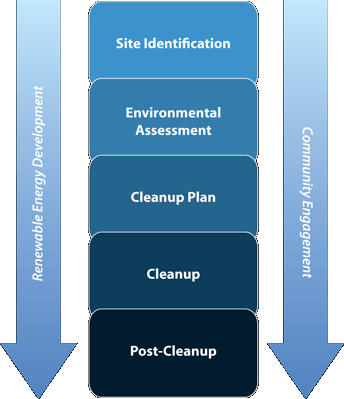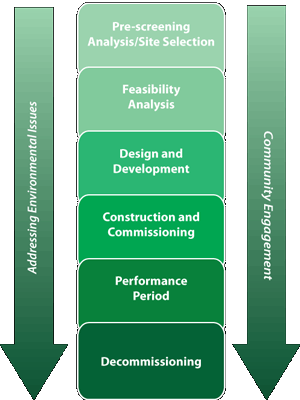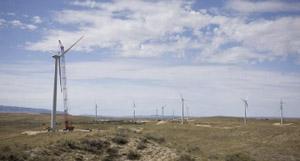Siting RE-Powering Projects While Addressing Environmental Issues
More information on how to integrate renewable energy development with typical cleanup processes can be found in the Handbook on Siting Renewable Energy Projects While Addressing Environmental Issues.
On this page:
- Typical Land Cleanup Process
- Renewable Energy Project Development Process
- Opportunities for Siting Renewable Energy Production While Addressing Environmental Site Issues
Typical Land Cleanup Process
EPA’s land cleanup programs have different cleanup processes and requirements; however, the basic steps of each program’s process are similar.
 Site Identification
Site Identification
The contaminated site is characterized in terms of location, types of structures, and potential contamination.
Environmental Assessment
The site is investigated to determine the nature and extent of contamination. If possible, future reuse of the site should be determined at this stage since it could significantly impact the cleanup process.
Cleanup Plan
If the site was found to have contamination in the preceding step, a cleanup plan is designed based on information gathered during the environmental assessment. However, not all potentially contaminated sites will require cleanup.
Cleanup
The cleanup plan is implemented. Cleanup technologies such as groundwater pump-and-treat can take several years but often require little of a site’s useable acreage.
Post-cleanup
Some sites may require monitoring and institutional controls (ICs) to ensure protection of human health and the environment.
Renewable Energy Project Development Process
Similar to EPA’s various cleanup programs, the different types of renewable energy projects (e.g., solar, wind, etc.) have unique siting requirements. However, the basic phases across the different types of renewable energy projects are similar. Thus, the process allows one to tailor and adapt the process to address unique or special-case needs inherent in site cleanup and reuse. In some instances, multiple phases can be combined or accelerated without compromising cleanup quality or development success— making it potentially possible to design and site a renewable energy facility at any step in the land cleanup process.
 Pre-screening Analysis/Site Selection
Pre-screening Analysis/Site Selection
Screen sites to identify and prioritize locations for further study. Preliminary screenings are often based on maps of renewable energy resources, prevailing utility rates, and incentives to determine if the project merits a more serious investment of the time and resources required by a feasibility analysis.
Renewable Energy Feasibility Analysis (Site-specific assessment)
A detailed analysis of the project is designed to provide technology and financing recommendations; identify all physical issues, including space for the systems; determine technical performance potential and economic viability; and identify environmental, social or other constraints that may impede project execution.
Design and Development
Design and planning of the physical aspects of the project, including documenting the intent of the design and creating the protocol by which the system performance will be evaluated. This step also covers any required instrumentation; and the arrangement and negotiation of financial, regulatory, contractual, and other nonphysical aspects.
Construction and Commissioning
Construction or installation of the renewable energy facility, and assessment of the degree to which the system fulfills the intent of the design.
Performance Period
Operations and maintenance activities performed throughout the operating period of the facility, including regular confirmation that the facility is working according to specification and warranties through measurement and verification.
Decommissioning
Removing a facility at the end of a project’s life. This process involves issues such as equipment replacement, permit revision, and new financing; and negotiating a new lease agreement, purchase power agreement (PPA), and buyer for the resultant renewable energy certificates (RECs), etc.
Opportunities for Siting Renewable Energy Production While Addressing Environmental Site Issues
- Project Profile: Casper Winds, Evansville, Wyoming

Industrial operations on the 880-acre former Texaco Casper Refinery site in Evansville, Wyoming, began in 1922 and lasted until the early 1980s. Sitting idle since that time, the site underwent environmental assessments and was identified for Resource Conservation and Recovery Act Corrective Action (RCRA CA) by EPA in 1987.
Subsequent cleanup activities were started by the Chevron Environmental Management Corporation, through the Wyoming Department of Environmental Quality’s (WDEQ) Voluntary Remediation Program. Cleanup included the treatment of petroleum-contaminated groundwater, engineering controls to prevent contaminant migration, and institutional controls (in this case, a Use Control Area or UCA) prohibiting excavation of contaminated soils.
With the push for renewable energy increasing, a portion of the former refinery site was determined as ideal for the installation of wind turbines. WDEQ determined that the targeted area did not have soil contamination and was sufficiently isolated from ongoing cleanup activities, and exempted the area from the UCA. Eleven 1.5 megawatt (MW) wind turbines were constructed approximately two miles away from an area of the RCRA CA site where groundwater cleanup is ongoing.
The turbines began operation in December 2008 and generate as much as 16.5 MW during peak times. They deliver energy to the grid through a power purchasing agreement with Rocky Mountain Power.
There are several different scenarios under which renewable energy development may be appropriate and ensure continued protectiveness such as:
- No Cleanup Necessary: Initially, the site may have been considered contaminated. However, after assessing the site, it is determined that levels of contamination do not pose unacceptable risk to human health and the environment.
- Before Cleanup: There are areas of the site that have no contamination and/or it is determined that there are areas available for renewable energy development that do not pose unacceptable risk to human health and the environment.
- Ongoing cleanup: While cleanup occurs on contaminated areas, areas that do not pose an unacceptable risk to human health and the environment are identified where renewable energy could be developed.
- After Cleanup: After cleanup is complete on contaminated areas of a site, renewable energy may be installed as long as the site remains protective. Renewable energy development must be designed to accommodate any engineered (e.g., landfill cap) or ICs (e.g., restrictive covenants) implemented as part of the cleanup to ensure there is no risk to human health or the environment.
- Groundwater Treatment Sites: There may be no risk to human health and the environment on the surface of a site where active groundwater treatment activities are ongoing. In many cases, renewable energy equipment can be installed without disturbing the groundwater treatment system. If groundwater treatment is complete but monitoring is ongoing, renewable energy development may also occur as long as monitoring wells remain accessible and undisturbed.
